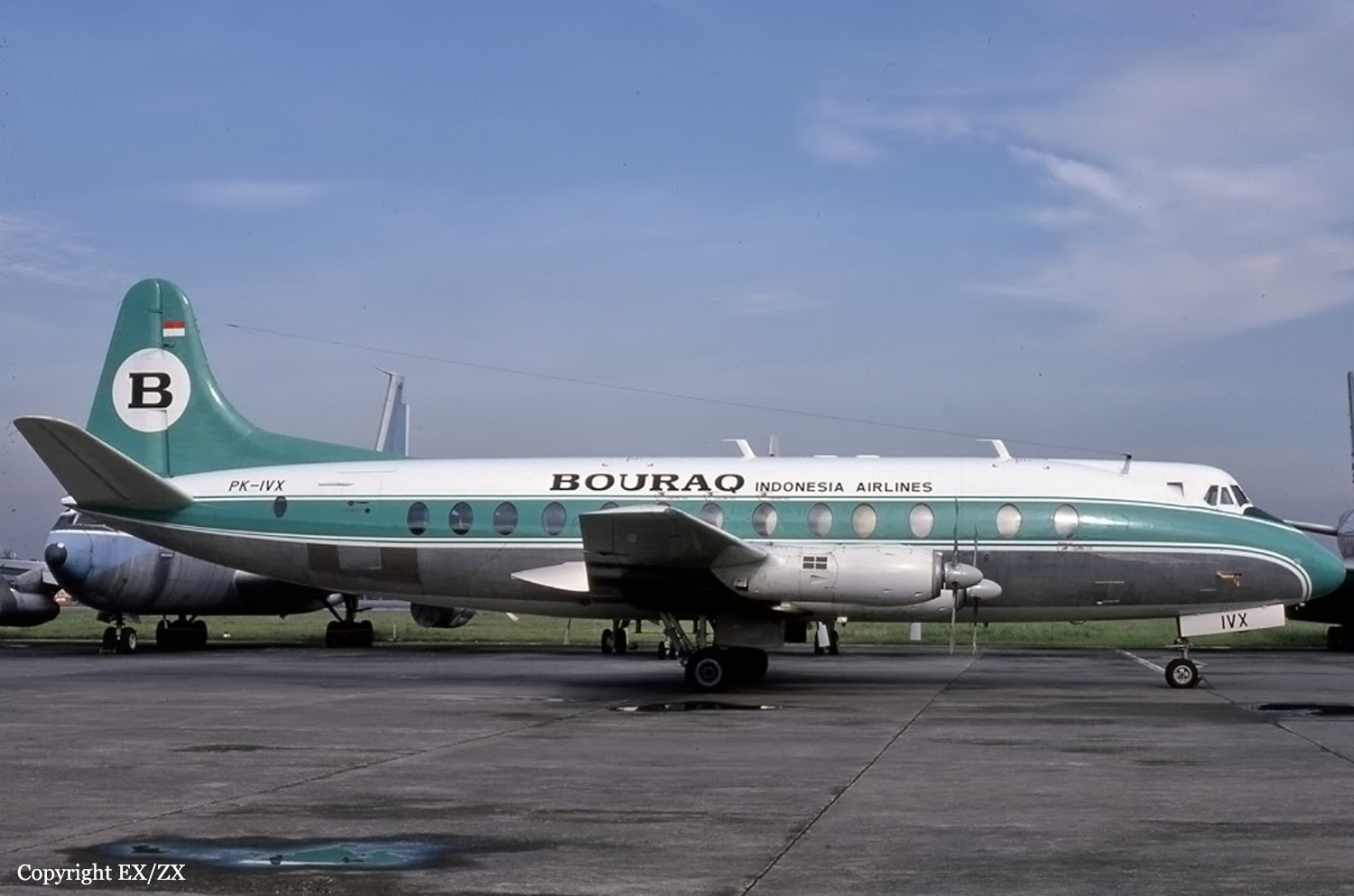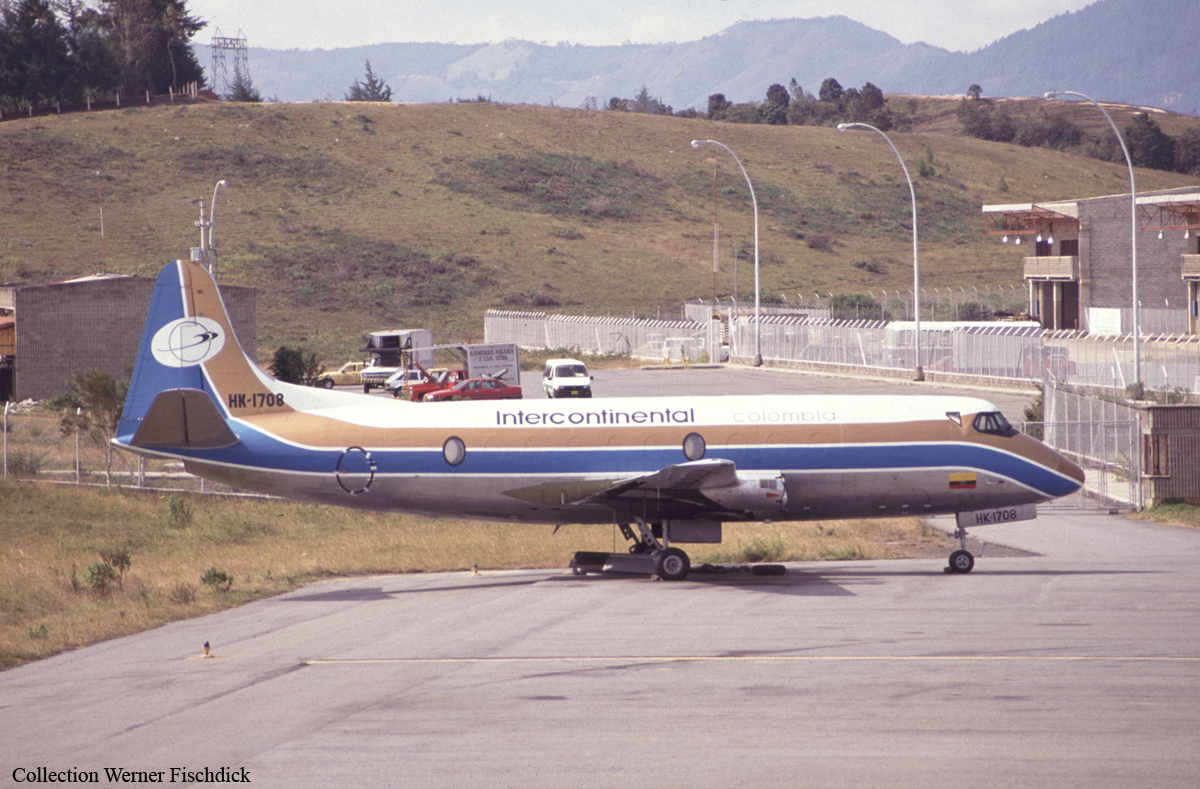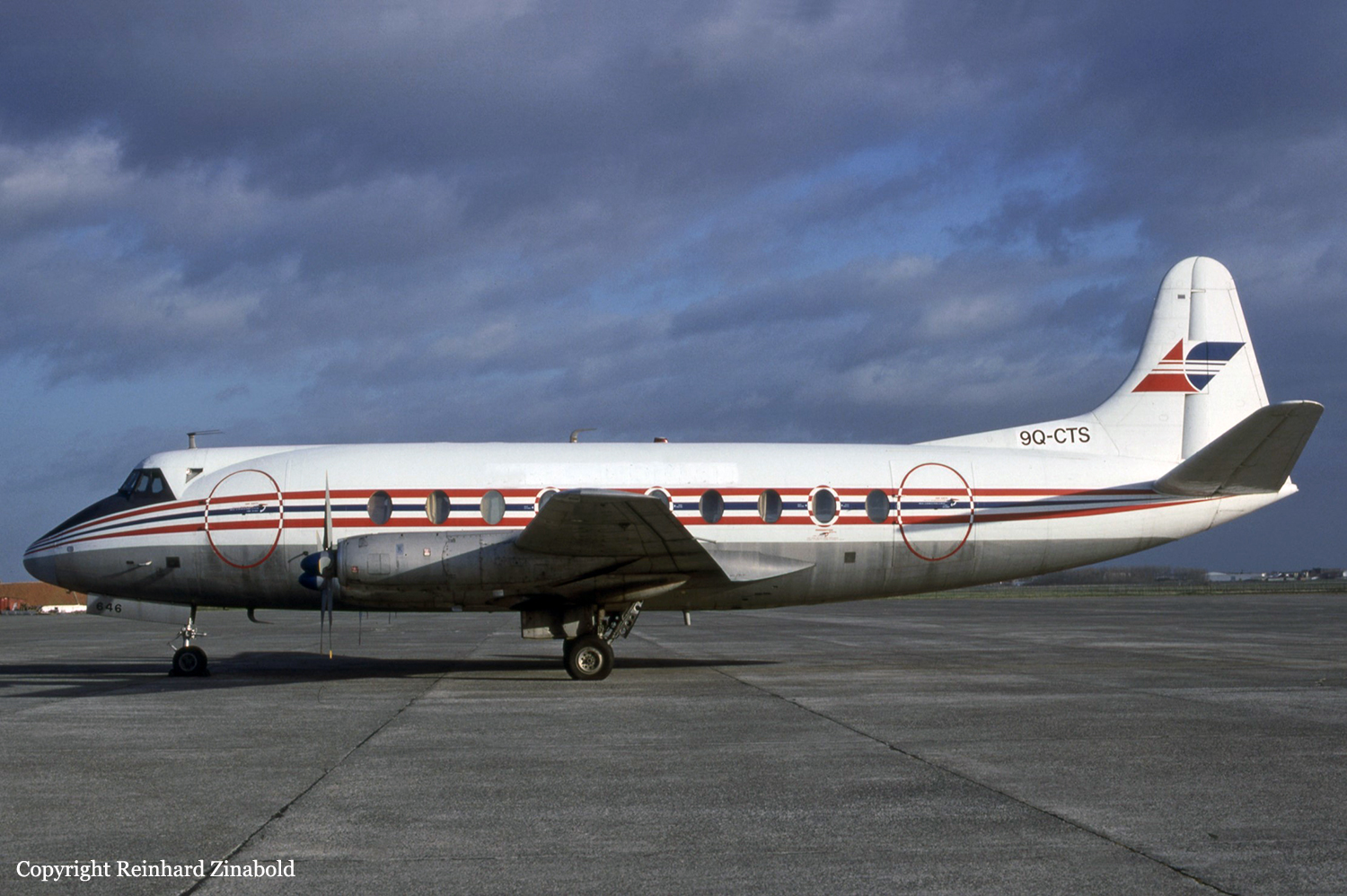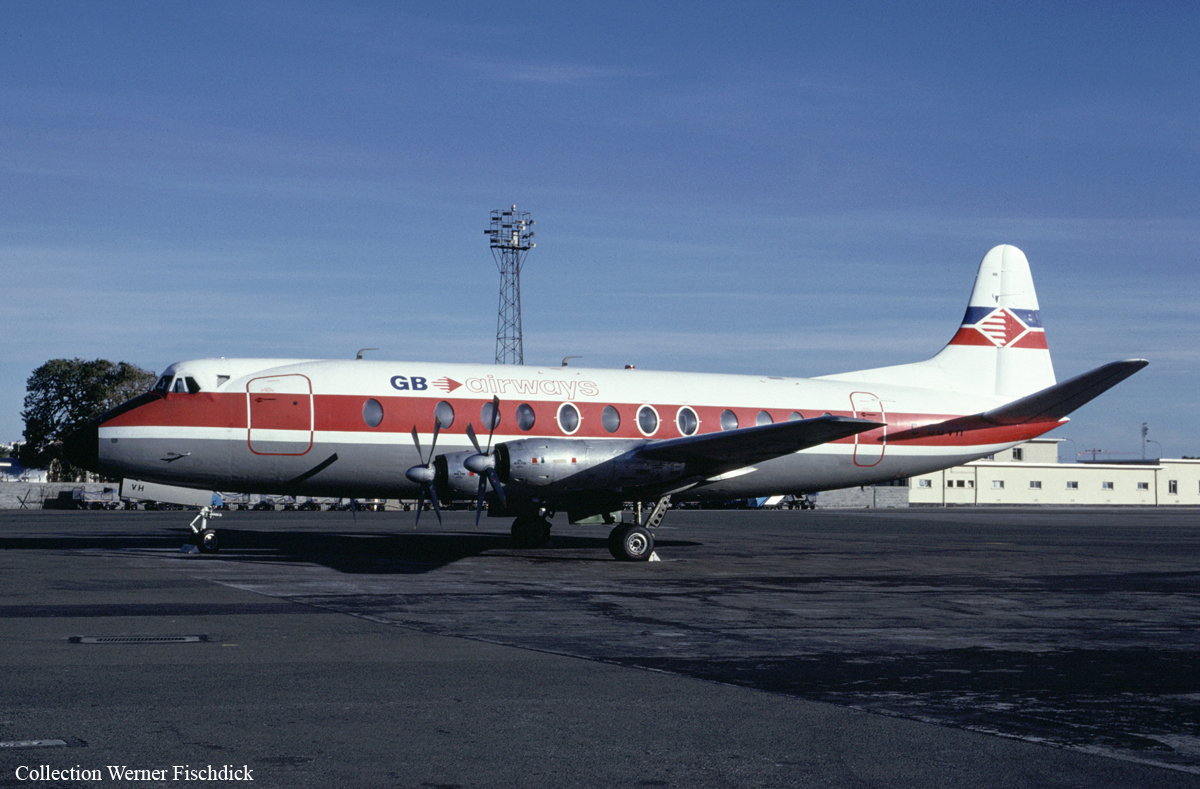Country
Crash of a Vickers 781D Viscount near Irumu: 23 killed
Date & Time:
Jun 6, 1997
Registration:
9Q-CWL
Survivors:
No
Schedule:
Bunia - Kisangani
MSN:
280
YOM:
1958
Crew on board:
3
Crew fatalities:
Pax on board:
20
Pax fatalities:
Other fatalities:
Total fatalities:
23
Circumstances:
After takeoff from Bunia Airport, the captain informed ATC about engine problems and reported fire in the cabin. Shortly later, the four engine aircraft went out of control and crashed about 40 km southwest of Bunia, in the region of Irumu. All 23 occupants were killed.

Crash of a Vickers Viscount 808 in Belfast
Date & Time:
Mar 24, 1996 at 2135 LT
Registration:
G-OPFE
Survivors:
Yes
Schedule:
Belfast - Belfast
MSN:
291
YOM:
1958
Crew on board:
2
Crew fatalities:
Pax on board:
0
Pax fatalities:
Other fatalities:
Total fatalities:
0
Captain / Total hours on type:
3918.00
Circumstances:
The two crew members had reported at Stansted at 1130 hrs to catch a passenger flight to Belfast where they were rostered for a training detail; immediately prior to this duty day, they both had two days off. The first officer had completed a command course on the simulator the previous week and this training detail was part of his conversion to the left hand seat; the training captain had also been involved in the simulator the previous week. The detail was planned to involve two flights; the first would cover the mandatory items for the type rating test (1179) and the second would complete the first officer's base check and initial line check. On arrival at Belfast, the crew checked in to the airport hotel,changed into uniform and went to the meteorological office at approximately 1600 hrs for a weather briefing. This briefing indicated that the weather was close to the limits required for the completion of the type rating test items but, with a forecast of a suitable area to the north of the airfield, the crew decided to carry on with the detail. For the first flight, G-OPFE left the stand at 1815 hrs and took off at 1827 hrs. All the necessary items were completed successfully, albeit with some difficulty because of the variable cloud base, and the crew landed at 2010 hrs. By 2015 hrs, G-OPFE was back on stand and the crew kept the engines running while they had a short brief for the second flight. At 2025 hrs,they taxied off stand and positioned for a departure off Runway 07. On this second flight, following a take off at 2031 hrs, the training captain initiated an outboard engine failure just after VR by retarding the associated throttle. The appropriate remedial actions were simulated andthe first officer carried out a 3 engine ILS approach and go-around to Runway 17; there had been no abnormal switch positions required because of the simulated engine failure. The go-around was followed by a 3 engine VOR approach to landon Runway 07. The different runways were used because there is no ILS on Runway 07, the runway in use. After landing,the first officer repositioned G-OPFE and made a full power take-off from Runway 07, commencing his roll at the intersection with Runway 17. The aircraft was climbed to 4,000 feet amsl and established in the cruise at 200 kt IAS. During this cruise, there were no unserviceabilities noted with G-OPFE. The crew continued in a north-westerly direction until approximately 5 nm from Eglinton Airport when they requested, and were given, permission to turn back towards Belfast International Airport. For the subsequent approach, the surface wind was 090°/15 kt,visibility was 2,500 metres and the cloud was scattered at 1,000 feet and overcast at 4,200 feet agl. After establishing contact with Aldergrove radar, the crew were cleared to commence a VOR/DME approach to Runway 07 for afinal landing. It was confirmed from the CVR that the 'Initial Approach' checks were completed 'down to the line'. However,although the first officer at one stage commented that it was a bit early to complete the rest of the 'Initial Approach' checks,there was no evidence that these or the 'Finals' checks were subsequently requested or actioned. The landing gear would normally be selected down during the 'Initial Approach, below the line' checks and confirmed during the 'Finals' checks. The final approach profile was closely monitored by the commander and, from comments on the CVR, the approach appeared very stable. In the later stages of approach, the first officer was heard asking for 85% flap andthe training captain was heard confirming this selection. These were the only comments heard referring to flap selection or position,although it is acceptable company practice for crews to request flap changes by visual means. The final flap position (100%)is used to decrease ground roll and is selected during the flare or after touchdown. Other relevant comments which were heardon the CVR included a reference to landing lights; this is the last item on the "Finals" checks. As the throttles were retarded in the flare, the gear warning horn was heard on the CVR, followed within 23 seconds by sounds of the propellers contacting the runway surface. After coming to a stop on the runway, the crew secured and evacuated the aircraft. The airport Rescue and Fire Fighting Service were on the scene inless than one minute.
Probable cause:
Subsequent runway and aircraft examination showed that G-OPFE had made a gentle touchdown on Runway 07 close to the PAPI position, somewhat left of the centreline. Initial contact wason both inboard propeller tips. After a few metres, both outboard propellers contacted the runway, progressively followed by radio aerials mounted beneath the fuselage, the fuselage undersurface, the inboard part of both inboard flaps and the No 3 engine nacelle. The aircraft continued down the left side of the runway,across the intersecting Runway 17/35, and came to rest on Runway 07 after a ground slide of approximately 480 metres. Damage consisted of severe bending and scraping of all propeller blades, abrasion of much of the undersurface of the fuselage and the No 3 engine nacelle lower cowl, and abrasion and moderate distortion of the inboard flaps A very small quantity of fuel was reportedly released from the No 3 engine nacelle. There was no fire. Examination showed that the flaps had been in the fully deployed position (100%, 47°) at touchdown and the flap lever was found selected at 47°. All three landing gear legs had been fully retracted at touchdown and throughout the ground slide. After the aircraft had been lifted, the three legs deployed into downlock without difficulty using the emergency lowering procedure. The landing gear selector was found with the 'Down' button pushed in, but the electric actuator that is switched by the selector was found in the fully up position; this actuator had not been disturbed during recovery operations. The landing gear indicator was found in the 'Day' (ie bright) setting. Examination and testing of relevant systems was carried out, except for the hydraulic generation system; this indicated that the landing gear operating and indication systems functioned normally.
Final Report:

Crash of a Vickers 813 Viscount in Uttoxeter: 1 killed
Date & Time:
Feb 25, 1994 at 1946 LT
Registration:
G-OHOT
Survivors:
Yes
Schedule:
Edinburgh - Coventry
MSN:
349
YOM:
1958
Flight number:
BWL4272
Crew on board:
2
Crew fatalities:
Pax on board:
0
Pax fatalities:
Other fatalities:
Total fatalities:
1
Captain / Total hours on type:
1121.00
Copilot / Total hours on type:
2181
Aircraft flight hours:
50995
Circumstances:
While on a cargo from Edinburgh to Coventry, cruising at FL150, the crew encountered severe icing conditions when engines n°2 and 3 failed. The crew was cleared to initiate an emergency descent to FL070 and FL050 and elected to divert to Birmingham Airport. Shortly later, he was able to restart the engine n°2 when the engine n°4 failed as well. The aircraft entered an uncontrolled descent and crashed in a wooded area located in Uttoxeter, about 45 km north of Birmingham Airport. The copilot was seriously injured and the captain was killed.
Probable cause:
The following causal factors were identified:
- Multiple engine failures occurred as a result of flight in extreme icing conditions,
- Incomplete performance of the emergency drills by the crew, as a result of not referring to the Emergency Checklist, prejudiced the chances of successful engine re-starts,
- Crew actions for securing and re-starting the failed engines, which were not in accordance with the operator's procedures, limited the power available. The drag from two unfeathered propellers of the failed engines and the weight of the heavily iced airframe resulted in a loss of height and control before the chosen diversion airfield could be reached,¨
- Poor Crew Resource Management reduced the potential for emergency planning, decision making and workload sharing. Consequently, the crew had no contingency plan for the avoidance of the forecast severe icing conditions, and also was unaware of the relative position of a closer diversion airfield which could have been chosen by making more effective use of air traffic services.
- Multiple engine failures occurred as a result of flight in extreme icing conditions,
- Incomplete performance of the emergency drills by the crew, as a result of not referring to the Emergency Checklist, prejudiced the chances of successful engine re-starts,
- Crew actions for securing and re-starting the failed engines, which were not in accordance with the operator's procedures, limited the power available. The drag from two unfeathered propellers of the failed engines and the weight of the heavily iced airframe resulted in a loss of height and control before the chosen diversion airfield could be reached,¨
- Poor Crew Resource Management reduced the potential for emergency planning, decision making and workload sharing. Consequently, the crew had no contingency plan for the avoidance of the forecast severe icing conditions, and also was unaware of the relative position of a closer diversion airfield which could have been chosen by making more effective use of air traffic services.
Final Report:
Crash of a Vickers 843 Viscount in Banjarmasin
Date & Time:
Aug 28, 1992
Registration:
PK-IVX
Survivors:
Yes
MSN:
454
YOM:
1963
Crew on board:
6
Crew fatalities:
Pax on board:
71
Pax fatalities:
Other fatalities:
Total fatalities:
0
Circumstances:
After takeoff from Banjarmasin-Syamsudin Noor Airport, while climbing, the crew declared an emergency after the engine n°2 caught fire. The crew shut down the engine, feathered its propeller and returned to the airport. A normal landing was completed and the crew stopped the aircraft on the main runway. All 77 occupants evacuated safely while the aircraft was destroyed by fire.
Probable cause:
Failure and fire on engine n°2 for unknown reasons.

Crash of a Vickers 798D Viscount near Mexico City: 4 killed
Date & Time:
Jul 27, 1992 at 1612 LT
Registration:
XA-SCM
Survivors:
No
Schedule:
Puebla - Mexico City
MSN:
392
YOM:
1958
Crew on board:
2
Crew fatalities:
Pax on board:
2
Pax fatalities:
Other fatalities:
Total fatalities:
4
Captain / Total hours on type:
63.00
Aircraft flight hours:
17213
Circumstances:
While approaching Mexico City-Benito Juarez Airport, the crew was cleared to descent from FL150 to FL120. In poor weather conditions, the crew continued the descent below FL120 when, at an altitude of 10,130 feet, the aircraft struck the slope of Mt Xocotlihuipa located 30 km east of the airport. The aircraft was destroyed and all four occupants were killed.
Probable cause:
Controlled flight into terrain after the crew failed to maintain FL120 as instructed by ATC while completing an IFR approach. It was reported that the copilot was not certified to act as a pilot on this type of aircraft. Also, the experience of the captain was limited.
Final Report:
Crash of a Vickers 816 Viscount in Ambon: 70 killed
Date & Time:
Jul 24, 1992 at 1630 LT
Registration:
PK-RVU
Survivors:
No
Schedule:
Jakarta - Surabaya - Ujung Pandang - Ambon
MSN:
434
YOM:
1959
Flight number:
RI660
Crew on board:
7
Crew fatalities:
Pax on board:
63
Pax fatalities:
Other fatalities:
Total fatalities:
70
Circumstances:
On approach to Ambon-Pattimura Airport, the crew encountered bad weather conditions with heavy rain falls. At an altitude of 2,300 feet, the four engine aircraft struck the slope of Mt Lalaboy located 14 km southwest of runway 04 threshold. The aircraft disintegrated on impact and all 70 occupants were killed.
Probable cause:
Controlled flight into terrain after the crew was approaching the airport at an insufficient altitude, maybe following instrument misreading or malfunction.
Crash of a Vickers 745D Viscount in Medellín
Date & Time:
Mar 31, 1991
Registration:
HK-1708
Survivors:
Yes
Schedule:
Bogotá – San Andrés
MSN:
138
YOM:
1956
Crew on board:
2
Crew fatalities:
Pax on board:
0
Pax fatalities:
Other fatalities:
Total fatalities:
0
Circumstances:
While cruising at an altitude of 16,000 feet on a cargo flight from Bogotá to San Andrés Island, the crew encountered atmospheric turbulences when both artificial horizons failed. The aircraft entered an uncontrolled descent but the crew was able to regain control at an altitude of 4,000. The pilot declared an emergency and was cleared to divert to Medellín-José Maria Cordova Airport where the aircraft landed safely. Both pilots escaped with minor injuries while the aircraft was written off. Post accident inspection showed substantial airframe damage including a crack in the lower main spar boom extending across 35% of its chord. It is believed that the initial damage had been caused by a landing gear collapse 14 February 1988 which was then exacerbated by the loss of control during the turbulence on this flight.

Crash of a Vickers 757 Viscount in Tshikapa
Date & Time:
Dec 31, 1988
Registration:
9Q-CTS
Survivors:
Yes
MSN:
310
YOM:
1958
Crew on board:
0
Crew fatalities:
Pax on board:
0
Pax fatalities:
Other fatalities:
Total fatalities:
0
Circumstances:
Upon landing, the nose gear collapsed. The airplane slid for few dozen meters before coming to rest. There were no casualties. The exact date of the mishap remains unknown, somewhere in 1988.

Crash of a Vickers 807 Viscount in Tangier
Date & Time:
Nov 23, 1988
Registration:
G-BBVH
Survivors:
Yes
Schedule:
Gibraltar - Tangier
MSN:
281
YOM:
1957
Crew on board:
4
Crew fatalities:
Pax on board:
74
Pax fatalities:
Other fatalities:
Total fatalities:
0
Circumstances:
The approach to Tangier-Boukhalef Airport was completed in heavy rain falls with a wind from 060° gusting at 24 knots. After touchdown on a wet runway, the crew encountered difficulties to decelerate. Following a course of about 1,000 meters on runway 28, the four engine aircraft veered off runway to the left and came to rest in a ditch. All 78 occupants escaped uninjured while the aircraft was damaged beyond repair.
Probable cause:
The assumption that the loss of control was the consequence of aquaplaning was not ruled out.






